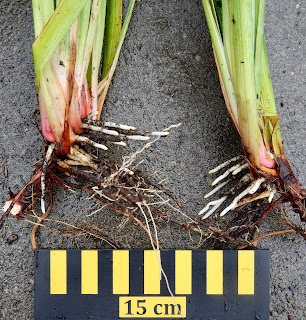Kathleen Sayce, May 2024
This spring I heard from two gardeners on the East Coast. Each is successfully growing Pacifica iris in very different geographic areas: Nova Scotia and North Carolina.
 |
| PCI Fundy Blue clump in Gordon's garden, Nova Scotia |
By success, I mean these gardeners have grown PCI for more than a few years, and began with seeds rather than transplants, and some of these plants have survived from year to year, flowering and setting seed.
In Nova Scotia Gordon Tingley started with an Iris innominata x I. douglasiana seed lot from Society for Pacific Native Iris’s winter seed catalog, and with seeds from his prior garden in Portland, Oregon.
In Raleigh, North Carolina, John Dilley began with seed from Parks Seeds, these PCI seeds were of unknown origin.
 |
| One of John's PCI |
In both cases, very few seedlings survived, and both gardeners focused on growing on the survivors, and their progeny.
John lives in Raleigh, North Carolina. North Carolina has all the summer weather traits that PCI dislike: hot muggy weather, warm summer rain, old soils high in clay, with poor root drainage. Yet he has thriving plants. Muggy hot summers are usually fatal to PCI across much of the middle and southeastern areas of North America.
 |
| Another PCI in John's garden |
In the F1 generation of seedlings in John’s garden there was considerable flower variation from that first PCI. He plants surviving seedlings in the ground after year two, letting them live, or die, in pots for the first couple of years. He’s shared some transplants to Tony Advent, Plant Delights Nursery, to propagate for potential sale in a few years.
Gordon lives in Bear River, Nova Scotia. He protects his PCI in the winter garden with conifer boughs, and gardens on granite-derived soils. Drainage is good, nutrition is good, and the maritime summer climate is more moderate than further south. Winter cold is the key selection factor in this garden.
 |
| From PCI 'Wilder Than Ever', in Gordon's garden |
 |
| PCI Fundy Blue in Gordon's garden, Nova Scotia |
More will be written about these gardens for Pacific Iris. This is the first good sign I have seen of nature working with gardeners to successfully produce both more cold winter and hot summer tolerance in Pacifica Iris in other regions of North America.

































